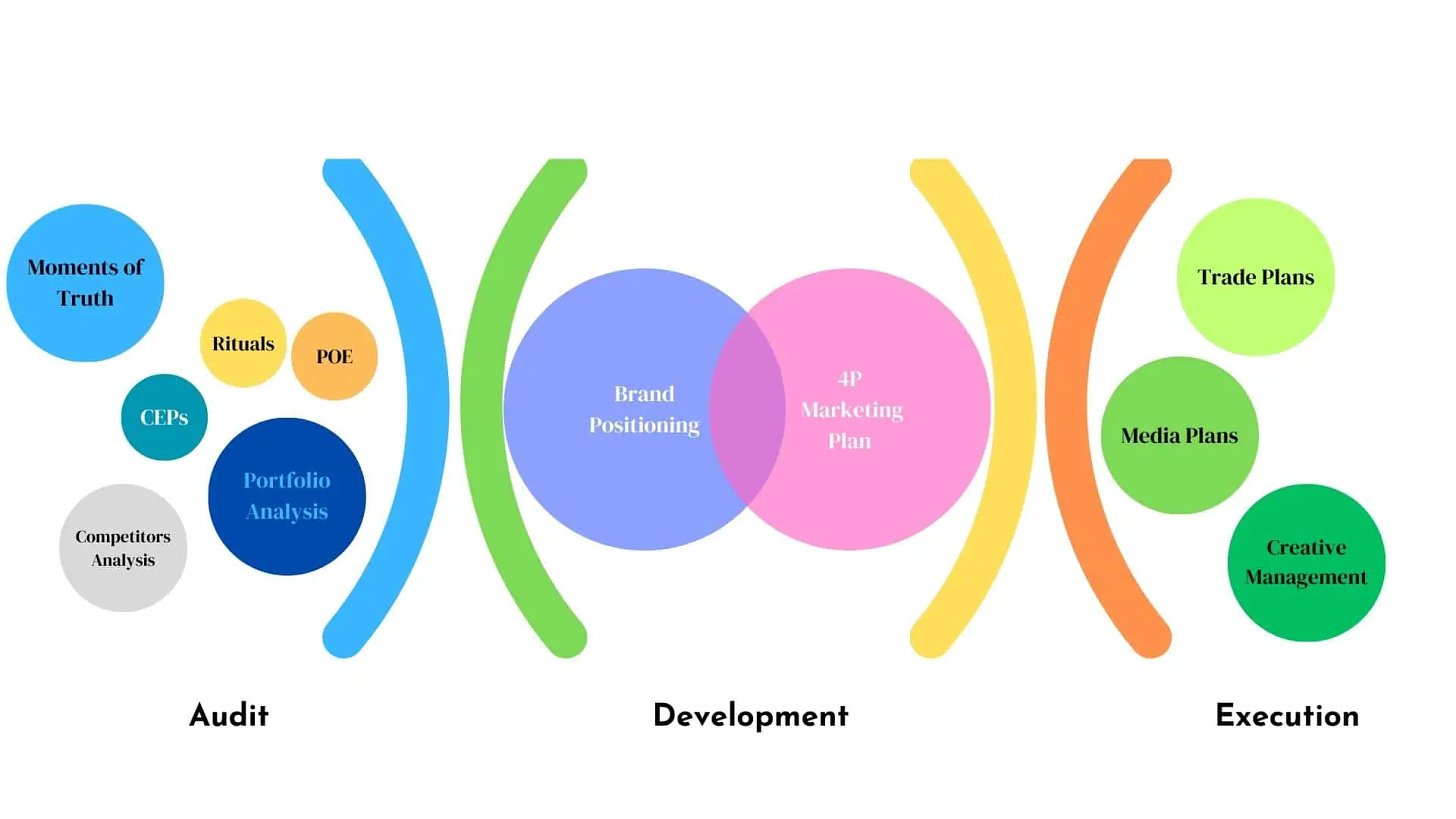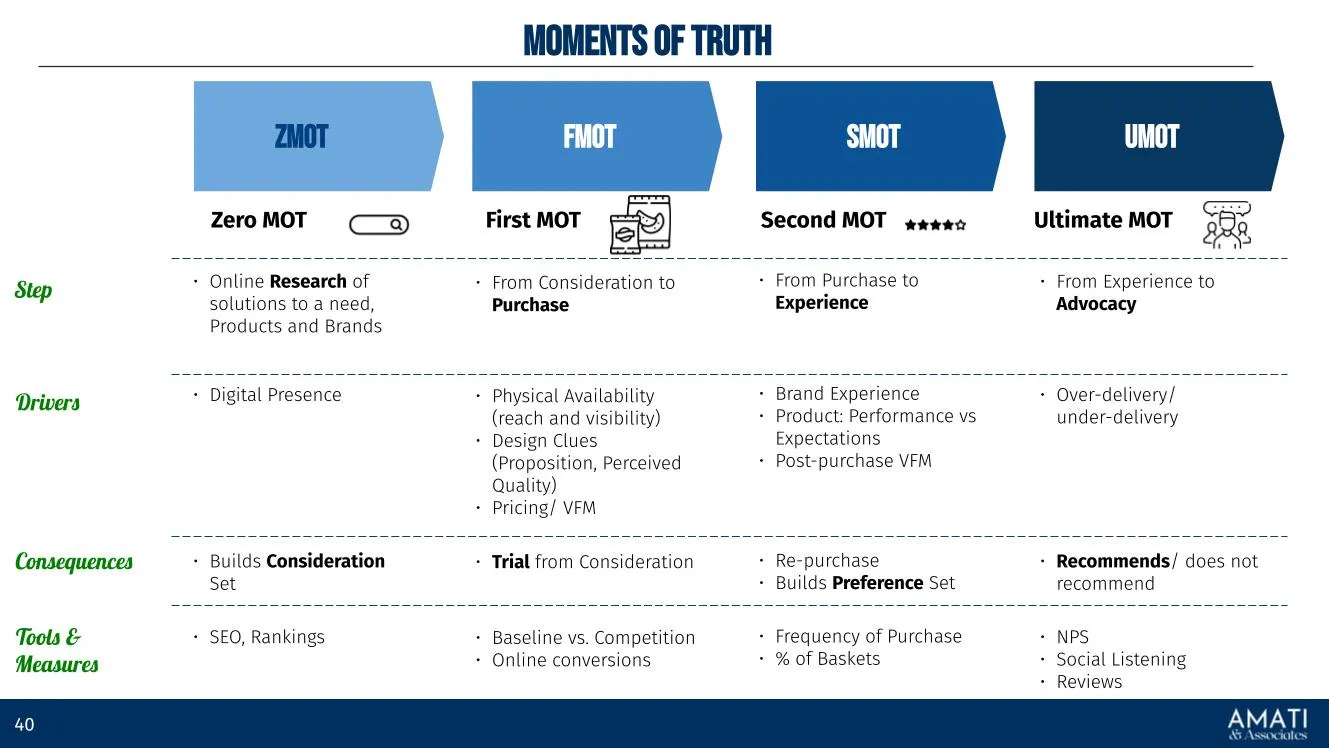High Potential Organizations
Our primary collaboration focus is engaging with high-potential organizations operating within the consumer goods sector and industrial manufacturers of food and beverages. These businesses typically share one or more of the following distinct traits:
Great Products
An excellent product needs a brand. These products are often built through a simplified marketing mix called the 2Ps: Product and Price.
Valuable Offerings
A well-designed offering needs a magical touch, e.g., more robust consumer and customer insights and a better-defined and focused brand positioning.
Local Jewels
A local gem ripe for international acceleration, a product, or a Brand needs an effective and affordable Internationalization Strategy.
With HTOs, we begin a transformative journey focusing on three strategic shifts:
From 2Ps to 4Ps marketing mix, including considerations of different consumption occasions and physical and mental availability, this broader approach aims to develop a more effective and holistic brand strategy.
Shifting from a traditional, category-centric competitive approach to thriving in a fluid market environment, where boundaries are less defined, and opportunities for innovation are plentiful.
Moving from trend followers to trendsetters skilled in forecasting and influencing future market trends, ensuring they remain leaders in their industry through foresight and innovation.
Today, I want to focus on HTOs that stick to a simplistic 2Ps marketing mix focusing solely on Product and Price. While it is sufficient to develop and commercialize a good product, it is often insufficient to support long-term and sustainable growth. Modern brands need a holistic approach to thrive.
The 2P model
The traditional 4P marketing mix includes Product, Price, Placement, and Promotion, so how could companies limit themselves to only two Ps?
In reality, they focus on the product and use the price to leverage the rest. First, they often believe that their product is of the best possible quality and needs to stand out from the competition. While this is primarily a claim, it is positive because it motivates owners and employees and fills them with pride. This pride is the motivational engine for those organizations. However, the marketing road to hell is filled with good products that will sell 'themselves.'
On the other end, though, they leverage price, not as a strategic profit-making and competitive dimension but as the dimension to deliver the rest of the plan. So, pricing becomes the tool to build distribution. Pricing also becomes the lever to produce budgets for their customers and the customers of their customers in the value-to-chain. They exploit price to generate resources used to promote the product.
These 2P offerings encounter many issues: They tend to have limited awareness, and when they do, there is no promise or equity behind them. Their clients are pretty much in charge of promoting their products, and should they decide to swap those products with a competitor's, the business drops dead.
The essential benefits of a 4P Strategy
The essential expansion to a 4Ps strategy, which includes Place and Promotion, provides a roadmap for brands (not products) aiming to enhance their market presence and consumer connection.
1. Cultivating a Brand Essence Beyond Product Benefits
Every product serves a function, but what elevates a brand above its competitors is often not the product itself but the values it embodies.
By integrating the core values into every aspect of a marketing strategy, a brand can achieve an authentic identity that resonates with modern consumers.
Products cannot sell themselves effectively because they cannot set the right expectations as products alone. In consumer marketing, quality and value for money are a game of performance vs. expectations. A product is—at least— good quality if it performs as good or better than expected, and those expectations are often non-technical or functional. Likewise, a product has a good value for money if it performs as well as expected or is better than expected.
Building a brand's essence also has the implied benefit of transforming everyday transactions into meaningful relationships.
Tactically, leveraging only 2Ps is like sailing without a helm: competitors can effectively lower their pricing to put pressure on a 2Ps offering and make operating unsustainable: if prices cannot be matched, distribution and visibility risk disappearing.
2. Achieving Global Reach with Local Impact
The global market is vast, and local nuances are critical. A successful 4Ps strategy crafts messages that resonate universally while embracing local cultures and preferences, creating a powerful emotional connection with diverse consumer bases.
Customizing your product to meet local markets' specific needs and preferences is a fundamental aspect of the 4Ps strategy. This might involve altering flavors, ingredients, or packaging based on cultural preferences and local consumer behavior. For example, a food product might be less spicy in markets where milder flavors are preferred, or a beauty product could be formulated differently for varying climatic conditions.
Pricing strategies must be sensitive to the local economic environment, including factors like average income levels, regional competition, and purchasing power parity. For instance, tiered pricing strategies can make products accessible to a broader range of consumers while maintaining profitability. In some cases, brands might implement market penetration pricing in lower-income regions to build a customer base, subsequently adjusting prices as brand loyalty and market share increase.
Choosing the proper distribution channels is critical to ensuring products are accessible where and when consumers want them. This involves selecting between online or brick-and-mortar outlets and understanding each locale's most popular retail formats, such as convenience stores in Japan or hypermarkets in France. Furthermore, logistics such as local warehousing and transportation must be optimized to meet consumer expectations for delivery times and product availability.
Promotions should be carefully tailored to resonate with local audiences. This goes beyond translating marketing materials into the local language and extends to adapting imagery, messaging, and media channels to align with cultural norms and values. Campaigns should reflect local traditions, holidays, and humor to enhance relevance and engagement. For example, advertising campaigns during major regional festivals like Diwali in India or Lunar New Year in China can significantly increase local consumer engagement.
Creating powerful emotional connections with consumers is often achieved through community engagement and local partnerships. This can include sponsoring local events, collaborating with local influencers, and engaging in corporate social responsibility initiatives that address regional issues. These activities help build brand affinity and trust, showing that a brand understands the local market and is committed to contributing positively to the community.
By meticulously applying these tailored strategies within the 4Ps framework, brands can effectively navigate the complexities of global markets. This approach ensures broad international reach and profound local impact, resulting in a worldwide robust, culturally adept, and consumer-centric brand presence.
3. Strategic Evolution for Consistent Relevance
Brands must evolve to stay relevant. However, change should come at a cost other than what made your brand appealing in the first place.
A 4Ps approach is consistent with making gradual changes. This allows customers to adjust and allows you to test and refine new strategies based on real-world feedback. For example, a restaurant might introduce a few new menu items alongside the classic dishes rather than replacing the entire menu simultaneously.
After implementing changes, the 4Ps models support monitoring their impact and making necessary adjustments when necessary. This could involve tweaking a new product, altering a marketing campaign, or rolling back changes if they do not resonate as expected. The goal is to be responsive and flexible, ensuring the brand stays relevant and continues growing and thriving.
4. Tapping into the Digital Space for Competitive Advantage
The digital world is a battleground where visibility and engagement are paramount. Establishing a robust online presence through clever digital marketing strategies (SEO and social media charisma) can set your brand apart, especially in consumer goods, where the Zero Moment of Truth is critical to building a consideration set.
5. Amplifying Brand Advocacy
In the age of social proof, brand advocates are invaluable. This section will focus on identifying and collaborating with genuine advocates—satisfied customers, influential bloggers, and other stakeholders—who can amplify your brand's message authentically, delivering on the Second Moment of Truth and beyond.
Conclusion
Adopting a 4Ps marketing strategy is not just about adding two more elements to your mix; it's about thinking more broadly and deeply about positioning your brand for long-term success. From enhancing your brand's essence to leveraging digital platforms for growth, the 4Ps approach offers a robust framework for building a resilient, relatable, and revered brand.







